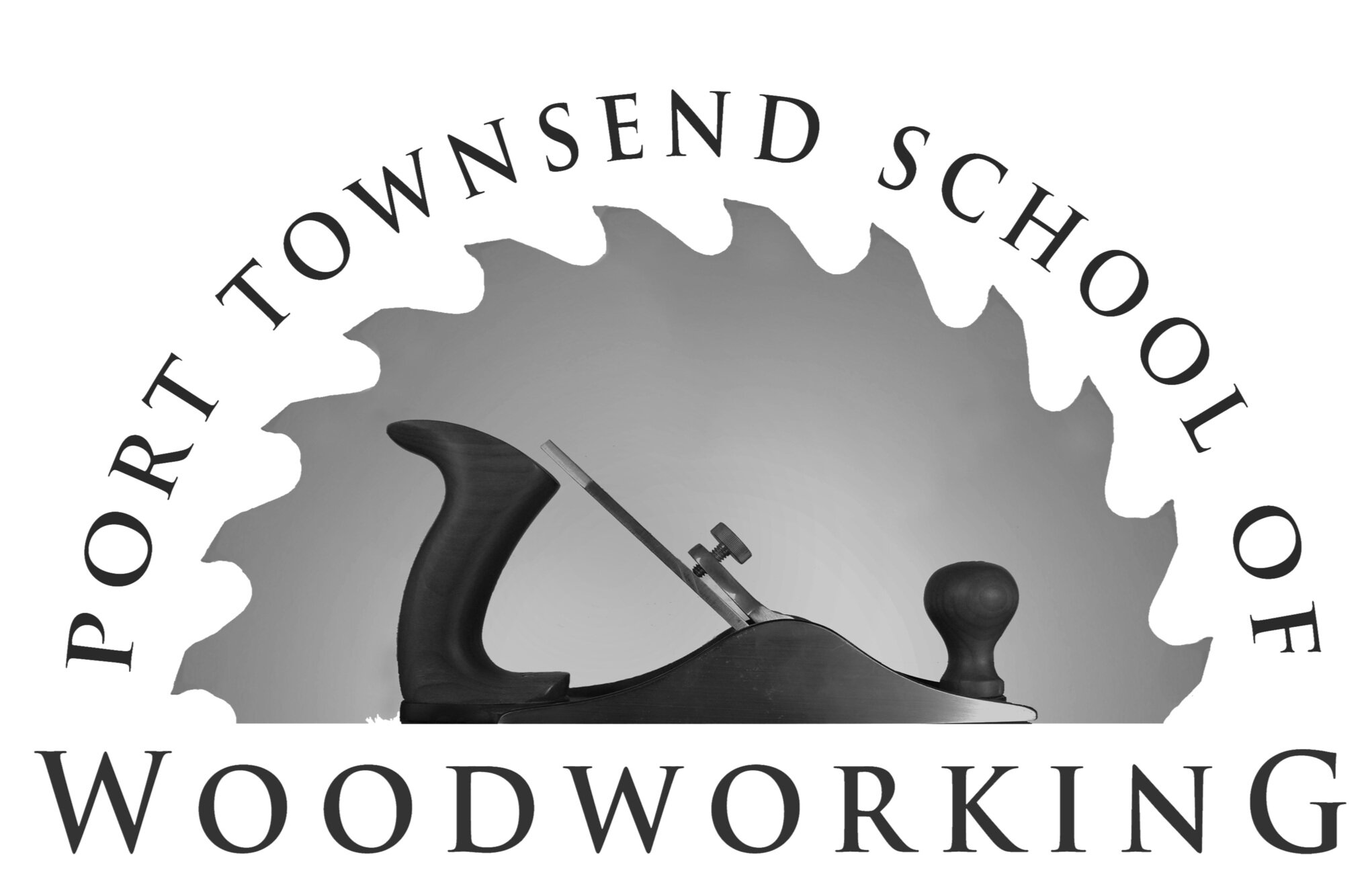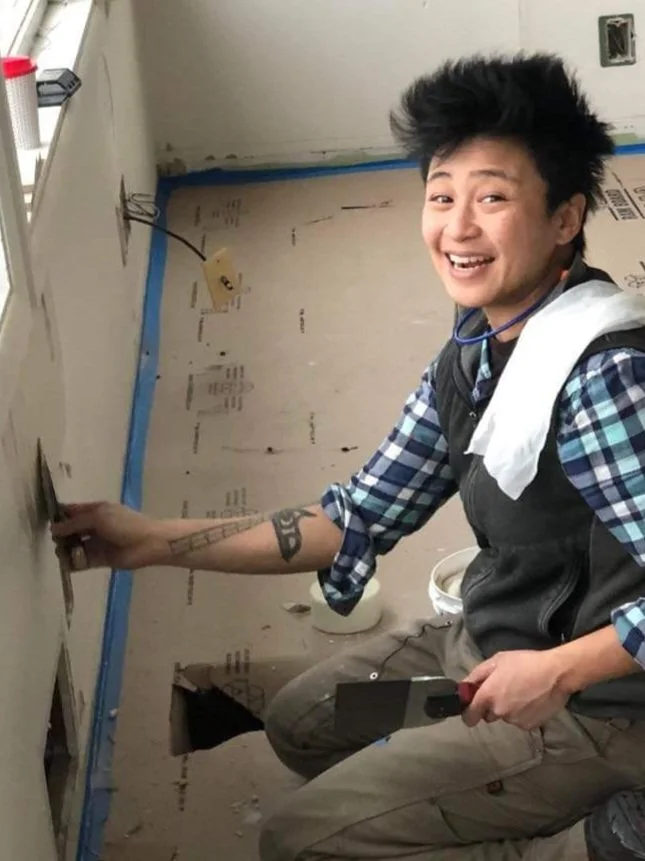Built Environment: Timber Frame Tiny House
8 Weeks, Some Skills Required
Summer 2023
July 10-Sept. 1
Our Philosophy Behind the Course
Shelter is a basic human need. This course will appeal to folks who are interested in shaping their built environment to make or maintain their shelters. As a class team we will build a tiny timber frame house discussing, practicing, and completing the steps of timber framing / in-fill stick framing, roofing, window and door installation, siding, and exterior trim work. You should walk away from this course knowing how to build and finish the exterior envelope of your own structure using the techniques explored in this class.
The Built Environment: Timber Frame Tiny House program is an eight-week course designed to equip students with a foundational understanding of wooden buildings and their exterior envelope. During this course, students will build a timber framed small structure complete with building envelope features such as roofing, siding, windows, and doors. The majority of instruction is demonstration/lecture with hands-on practice in the shop and onsite. The course completes a 10’ by 26’ tiny house on a moveable trailer during this eight-week period. This structure is sold to help fund the operations of the school..
Curriculum
Timber Framing
Students will take away a conceptual understanding of the timber frame design, history, and building process reinforced by the hands-on experience of creating a small timber framed building. Students will also complete and take home their own timber horses; using joinery and layout techniques used in timber framing.
What is timber framing? Unlike stick framing (also known as stud or dimensional framing) which relies on nails, screws, and metal brackets to hold the building together, timber framing relies on joinery to connect the framing members. The joints are cut, fit together, and then pinned with wooden pegs to hold them in place.
Building the Envelope
Students will understand how to complete the exterior of a building using the timber frame tiny home as our group project. Tasks and topics covered will include, but not be limited to: sheathing, roofing, window and door installation, insulation, rain screen, siding, and trim.
Projects and Course Outline
Week 1 - Introduction to Timber Frame and Timber Horse Construction
History of timber framing
Design concepts
Sharpening and maintenance of the tools
Joinery layout and cutting
Applications of mortise and tenon joinery for framing walls and roofs
Building a pair of timber horses
The first week introduces you to the skills, tools, and concepts of timber framing as well as our overall project. Each student will build a pair of traditional timber horses; an apprentice’s project for learning and practicing the methods you will use in timber framing. You will practice the mortise and tenon joints required for our actual timber frame. Plus, you’ll be building an essential tool: the timber horse. These timber horses work well in the shop or on site and provide a sturdy yet mobile base to do your layout as well as cut and chop the joinery. Students take these timber horses home with them at the conclusion of the course
Week 2 & 3: Cutting the Frame
Site planning and preparation
Tool selection and care
Materials choices
Design orientation
Planning for workflow and production schedule
Finish choices/standards
Production of framing members
Precision layout
Cutting joinery
Smoothing and detailing
Weeks two and three will be focused on cutting and fitting our timber frame project as a team, using mortise and tenon joinery. From the very beginning of a project you’ll need to take into consideration planning for the utilities, roofing, methods for constructing walls, siding choices, and pre-finishing the beams to be left exposed. You’ll learn how to anticipate these needs and design the frames appropriately.
Week 4: Raising the Frame & Infill Framing
Assembly sequence and process
Job site safety best practices
Hand raising strategies
Common lumber framing
Use of pneumatic tools
The class will collectively raise the frame under the supervision of our Lead Instructor. Emphasis will be on safety, industry standards, and strategies for hand-raising small frames. We will complete our infill framing with common lumber to finalize the framing of the structure.
Week 5: Roof and Wall Sheathing , Window and Door Installation
Wall assembly penetration discussion
Waterproofing and flashing discussion
Roof and Wall Sheathing installation
Review flashing techniques
Window installation
Door installation
The class will sheathe the entire building and cut window and door openings. These openings will be flashed and prepared for window and door installation. We will install two exterior doors and several windows of various sizes.
Weeks 6 & 7: Building Envelope
Survey of house wrap options and techniques
Review rainscreen details
Wall Assembly insulation discussion
House wrap installation
Insulation / Rainscreen installation
Roofing installation
These weeks will be focused on effectively wrapping, sealing, and insulating the building envelope. We will learn methods and techniques to help keep the house dry and warm on the inside.
Weeks 7 & 8: Siding and Exterior Trim
Survey of siding and trim materials and techniques
Install two types of wood siding
Install exterior trim
Use of pneumatic tools
These weeks will focus on the outward appearance of the house as well as the hard shell that will help the house endure the natural elements.
Required Tools
1-½” Framing or timber chisel
Block plane
Notebook
Framing squares 16”x24”
Speed square
Framing hammer, weighted for your personal safety and efficiency (at least 16 oz.)
25’ Tape measure (good quality, heavy duty)
Utility, striking, or layout knife
Mallet
Work gloves
Recommended Tools
Bench chisel set: various sizes
Personal protective equipment
Cordless drill and impact driver
Prerequisites
Some skills required. Students must have some experience with hand tool joinery; including sharpening as well as using saws and chisels to cut mortises and tenons. Completion of a PTSW Beginning Hand Tool Woodworking course is a good option. Students also must be able to meet the physical demands of the course; we are lifting heavy timbers and heavy tools all day long. Please contact us if you have questions about the tools required and your ability to meet the physical requirements.
Course Duration & Hours
This eight-week intensive runs from July 10-September 1, 2023. Classes take place from 9:00 am to 5:00 pm Monday through Friday in Building 304 at Fort Worden, with an hour break for lunch. We encourage you to arrive by 8:30 am to practice and prepare for the day.
Beyond the scheduled class time, the workshop is available after hours and on weekends. Please refer to the School’s After Hours Policy.
Accommodations
Lodging and accommodations in Port Townsend can be found at this link. We also maintain a list of homeowners who enjoy hosting students and offer a range of accommodations and reasonable rates. Please click this link to view the list. Students are responsible for all communications with homeowners.
Tuition & Registration Details
Before applying, please review the registration process and deadlines, tuition details, the tuition payment schedule, and our cancellation policies.
Submission Deadline- Six months before course start
Submission Deadline Extension- One month extensions to submission deadline as needed (if course is not full)
How To Apply
Applications are reviewed monthly, starting six months before the course date. After reviewing applications, we will schedule a brief phone interview to get a better sense of your woodworking experience and make sure the class is a good fit for you.
There is no fee for applying. Applications are completed online by students. You will receive a confirmation of your application by email after you submit your application. Please contact us if you do not receive this email. If you have questions, please call us at 360-344-4455 or email info@ptwoodschool.org.
Review application details and apply here.
GI Bill & “Voc Rehab” Funding for Veterans
Currently, all of our intensive programs are eligible to be covered by your VA benefits including our Built Environment: Timber Frame Tiny House. Our three consecutive 12-week intensives provide nine months of fine woodworking training and furniture design. Details on how to use your VA benefits.
Vocational Option
The Port Townsend School of Woodworking is licensed as a Washington State Private Vocational School. The school is not nationally accredited and regrettably cannot accept AmeriCorps Funds.
To learn more about our vocational option, including Vocational Rehabilitation for veterans which may cover tools, see our vocational catalog.
Scholarships
Our goal is to provide more access to fine woodworking education for all. If the tuition expense is a barrier, please consider applying for a scholarship.
Questions? Email info@ptwoodschool.org












